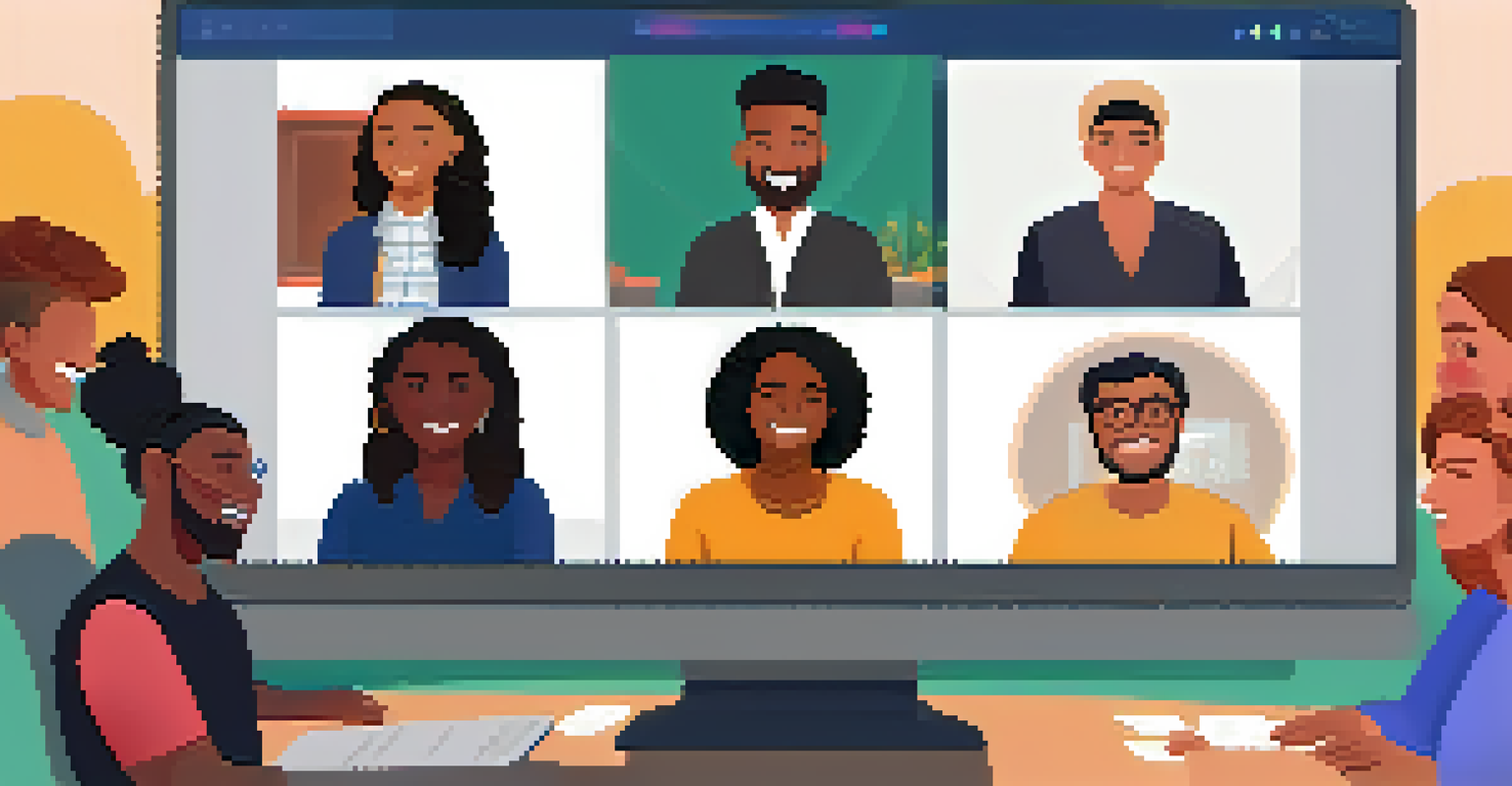Creating Inclusive Group Work with Digital Technologies

Understanding Digital Inclusivity in Group Work
Digital inclusivity is about ensuring everyone has equal access to digital tools and platforms. In group work settings, this means considering the diverse needs and backgrounds of all participants. It's essential to recognize that not everyone has the same level of comfort or experience with technology, which can create barriers to participation.
Diversity is not a reason for division, but a source of strength.
For example, a student may struggle with navigating a specific software, while another might be dealing with accessibility issues due to a disability. By being aware of these differences, group members can work together to create an environment where everyone feels valued and included. This foundational understanding sets the stage for effective collaboration.
Ultimately, fostering digital inclusivity not only enhances participation but also enriches the overall learning experience. When everyone contributes their unique perspectives, the group can create more innovative solutions and build a stronger sense of community.
Choosing the Right Digital Tools for Collaboration
Selecting the appropriate digital tools is crucial for inclusive group work. Consider platforms that are user-friendly and accessible to all group members. Tools like Google Docs or Trello offer collaborative features that allow everyone to participate in real-time, ensuring that no one feels left out.

It's also important to choose tools that accommodate different learning styles and preferences. For instance, some individuals may prefer visual content, while others might excel with audio or written formats. Providing a variety of options can help cater to diverse needs and encourage participation from all group members.
Foster Digital Inclusivity
Creating an inclusive environment allows all participants to contribute their unique perspectives, enhancing collaboration and learning.
Lastly, ensure that the chosen tools comply with accessibility standards. This not only promotes inclusivity but also demonstrates a commitment to creating an equitable learning environment. By prioritizing the right tools, groups can enhance collaboration and foster a sense of belonging.
Establishing Ground Rules for Inclusive Interaction
Creating ground rules helps set expectations for group interactions, making everyone feel safe and respected. These rules can include guidelines for communication, like encouraging active listening and valuing all contributions. By establishing these norms, groups can cultivate a supportive atmosphere where everyone is encouraged to share their ideas.
Inclusivity means not just 'we're allowed to be here,' but 'we're valued.'
For example, consider implementing a 'no interrupting' rule to give everyone a chance to speak. This can be especially helpful in diverse groups where some members may be more hesitant to voice their opinions. By fostering a respectful dialogue, you empower all participants to engage fully in the conversation.
Moreover, revisiting and updating these ground rules throughout the project can help address any emerging issues and maintain a positive group dynamic. Continuous reflection on group interaction ensures that everyone remains accountable and committed to inclusivity.
Encouraging Diverse Perspectives in Group Discussions
Encouraging diverse perspectives is vital for effective group work. Embracing different viewpoints not only fuels creativity but also helps the group arrive at more comprehensive solutions. To promote this diversity, consider using structured discussion techniques, such as 'round-robin' sharing, where each member has a chance to express their thoughts without interruption.
Additionally, creating an environment where members feel comfortable sharing their unique experiences can enrich discussions. For instance, you might start by asking each member to share a personal anecdote related to the project topic. This can help break the ice and encourage openness among group members.
Choose Accessible Tools
Selecting user-friendly digital tools ensures that all group members can participate effectively, accommodating diverse needs and preferences.
By valuing each person's input, groups can build on each other's ideas and create a more robust final product. This sense of collaboration not only enhances the quality of the work but also strengthens relationships among group members.
Utilizing Asynchronous Communication for Flexibility
Asynchronous communication allows group members to contribute at their own pace, accommodating varying schedules and comfort levels. Platforms like Slack or discussion boards enable participants to share their thoughts and feedback without the pressure of real-time interaction. This flexibility can be especially beneficial for students with different commitments or those who may need extra time to process information.
Moreover, asynchronous tools can reduce anxiety for individuals who might feel overwhelmed in live discussions. They provide a safe space for quieter members to articulate their ideas thoughtfully. This can lead to richer contributions and a more inclusive environment overall.
Encouraging the use of asynchronous communication also fosters accountability, as members are expected to check in regularly and respond to their peers. By embracing this flexibility, groups can enhance participation and ensure that every voice is heard.
Providing Support and Resources for All Participants
Offering support and resources is essential for fostering inclusivity in group work. This can include providing tutorials or guides for using chosen digital tools, ensuring that everyone has the necessary skills to participate effectively. Additionally, sharing resources related to the project topic can help level the playing field, allowing all members to contribute meaningfully.
Consider organizing a brief training session at the beginning of the project to familiarize everyone with the tools and resources available. This proactive approach can help alleviate any concerns and build confidence among group members. When individuals feel equipped with the right knowledge, they are more likely to engage actively.
Evaluate Group Dynamics Regularly
Regular check-ins and feedback mechanisms help maintain an inclusive atmosphere and address any emerging issues in group work.
Furthermore, creating a shared repository for resources can encourage collaboration and knowledge sharing. By providing access to materials, you empower all participants to contribute their insights and expertise, enhancing the overall quality of the group's work.
Evaluating Group Dynamics and Inclusivity Regularly
Regularly evaluating group dynamics is crucial for maintaining an inclusive atmosphere. Check-ins can provide an opportunity for members to express any concerns or challenges they're facing. This not only helps identify potential issues early on but also reinforces the importance of open communication in promoting inclusivity.
Consider creating a simple feedback mechanism, such as anonymous surveys or discussion prompts, to gauge how everyone feels about their participation. This feedback can be invaluable in making necessary adjustments and ensuring that all voices are heard. Regular evaluation shows that the group values each member's experience and is committed to creating a supportive environment.

By fostering a culture of reflection and accountability, groups can adapt to changing dynamics and continue to enhance inclusivity throughout the project. This ongoing commitment to improvement can lead to a more cohesive and effective team.
Celebrating Achievements and Diversity in Group Work
Celebrating achievements, both big and small, helps reinforce a sense of community within the group. Acknowledging individual contributions fosters a positive environment where everyone feels appreciated. This recognition can be as simple as a shout-out during a meeting or a shared message in a group chat, highlighting the unique strengths each member brings to the table.
Moreover, celebrating diversity within the group can enhance the overall experience. Consider hosting a reflection session at the end of the project where members can share what they learned from each other. This not only reinforces the value of diverse perspectives but also cultivates respect and understanding among participants.
By taking the time to celebrate successes and diversity, groups can strengthen their bond and create lasting memories. This positive reinforcement encourages ongoing collaboration and lays the foundation for future projects, making inclusivity a core value in group work.